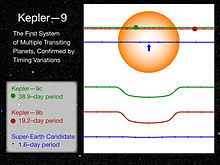astro.wikisort.org - Planeta
Kepler-9c es unos de los primeros 7 exoplanetas descubiertos por la Misión Kepler de la NASA, y, un mínimo de dos en el primer sistema extrasolar con múltiples tránsitos de planetas.[2][3]
| Kepler-9c | ||
|---|---|---|
 Comparación de tamaños de Kepler-9c con Júpiter. | ||
| Descubrimiento | ||
| Descubridor | Kepler | |
| Fecha | 26 de agosto de 2010 | |
| Categoría | planeta extrasolar | |
| Estrella madre | ||
| Estrella | Kepler-9[1] | |
| Constelación | Lyra | |
| Ascensión recta (α) | 19 h 2 m 17.76 s | |
| Declinación (δ) | +38°24′3.2″ | |
| Distancia estelar | 2120 años luz, (650 pc) | |
| Magnitud aparente | ~13 | |
| Masa | 1.07 M☉ | |
| Radio | 1.02 R☉ | |
| Temperatura | 5777 ± 61 K | |
| Metalicidad | +0.12 ± 0.04 (Fe/H) | |
| Edad | ~1 Ga | |
| Elementos orbitales | ||
| Inclinación | 89.188 grados sexagesimales | |
| Argumento del periastro | 167.5 grados sexagesimales | |
| Semieje mayor | 0.225 ± 0.001 UA | |
| Excentricidad | 0 | |
| Elementos orbitales derivados | ||
| Período orbital sideral | 38.91 días | |
| Características físicas | ||
| Masa | 0.171 ± 0.013 MJúpiter | |
| Radio | 0.823 ± 0.067 MJúpiter | |

Véase también
Referencias
- Guillermo Torres, François Fressin, Natalie M. Batalha, William J. Borucki, Timothy M. Brown, Stephen T. Bryson, Lars A. Buchhave, David Charbonneau, David R. Ciardi, Edward W. Dunham, Daniel C. Fabrycky, Eric B. Ford, Thomas N. Gautier III, Ronald L. Gilliland, Matthew J. Holman, Steve B. Howell, Howard Isaacson, Jon M. Jenkins, David G. Koch, David W. Latham, Jack J. Lissauer, Geoffrey W. Marcy, David G. Monet, Andrej Prsa, Darin Ragozzine, Jason F. Rowe, Dimitar D. Sasselov (27 de agosto de 2010). «Modeling Kepler transit light curves as false positives: Rejection of blend scenarios for KOI-377, and strong evidence for a super-Earth-size planet in a multiple system». .
- «Summary Table of Kepler Discoveries». NASA. 26 de agosto de 2010. Archivado desde el original el 1 de abril de 2017. Consultado el 1 de septiembre de 2010.
- Matthew J. Holman, Daniel C. Fabrycky, Darin Ragozzine, Eric B. Ford, Jason H. Steffen, William F. Welsh, Jack J. Lissauer, David W. Latham, Geoffrey W. Marcy, Lucianne M. Walkowicz, Natalie M. Batalha, Jon M. Jenkins, Jason F. Rowe, William D. Cochran, Francois Fressin, Guillermo Torres, Lars A. Buchhave, Dimitar D. Sasselov, William J. Borucki, David G. Koch, Gibor Basri, Timothy M. Brown, Douglas A. Caldwell, David Charbonneau, Edward W. Dunham, Thomas N. Gautier III, John C. Geary, Ronald L. Gilliland, Michael R. Haas, Steve B. Howell, David R. Ciardi, Michael Endl, Debra Fischer, Gabor Furész, Joel D. Hartman, Howard Isaacson, John A. Johnson, Phillip J. MacQueen, Althea V. Moorhead, Robert C. Morehead, Jerome A. Orosz (26 de agosto de 2010). «Kepler-9: A System of Multiple Planets Transiting a Sun-Like Star, Confirmed by Timing Variations». Science. doi:10.1126/science.1195778.
Enlaces externos
 Wikimedia Commons alberga una categoría multimedia sobre Kepler-9c.
Wikimedia Commons alberga una categoría multimedia sobre Kepler-9c.
На других языках
[en] Kepler-9c
Kepler-9c is one of the first seven extrasolar planets, exoplanets, discovered by NASA's Kepler Mission, and one of at least two planets orbiting the star Kepler-9. Kepler-9c and Kepler-9b were the first exoplanets confirmed to be transiting their star.[5][1] The planet's discovery was announced by the Kepler Mission team on August 26, 2010 after its initial discovery by Kepler. At the time, it was one of 700 planetary candidates noted by Kepler.- [es] Kepler-9c
[ru] Kepler-9 c
Kepler-9 с — одна из трёх известных экзопланет в системе Kepler-9. Открыта космическим телескопом «Кеплер»[2]. Имеет орбитальный период 38,91 дня[3].Текст в блоке "Читать" взят с сайта "Википедия" и доступен по лицензии Creative Commons Attribution-ShareAlike; в отдельных случаях могут действовать дополнительные условия.
Другой контент может иметь иную лицензию. Перед использованием материалов сайта WikiSort.org внимательно изучите правила лицензирования конкретных элементов наполнения сайта.
Другой контент может иметь иную лицензию. Перед использованием материалов сайта WikiSort.org внимательно изучите правила лицензирования конкретных элементов наполнения сайта.
2019-2025
WikiSort.org - проект по пересортировке и дополнению контента Википедии
WikiSort.org - проект по пересортировке и дополнению контента Википедии